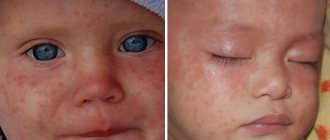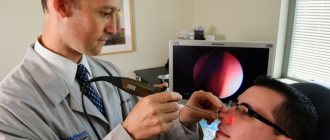MEASLES is an acute, highly contagious disease manifested by intoxication syndrome, catarrhal syndrome and specific exanthema. Despite the low incidence of measles in our country (0-2 cases per year), we must not forget that if the vaccination plan is not followed, the incidence of measles can increase sharply.
Measles is caused by a paramyxovirus, represented by a single serotype. The incubation period is 9-12 (up to 17) days, and with passive immunization and in vaccinated people - up to 21 days. The patient is a source of infection from the last two days of incubation until the 4th day from the moment the rash appears and is most contagious in the prodromal period. In the presence of pneumonia, the infectiousness of patients can increase up to 10 days from the moment the rash appears.
The prodromal (catarrhal) period of measles lasts 2-4 days. The clinical picture of measles in this period is characterized by an acute onset of the disease, severe intoxication and fever, conjunctivitis, and manifestations of catarrhal syndrome. It is necessary to pay attention to a thorough examination of the buccal mucosa to make a diagnosis of measles before the appearance of the rash by the presence of enanthema and Belsky-Filaty-Koplik spots. The presence of Belsky-Filatov-Koplik spots at the level of small molars is considered classic. However, in the prodromal period they are often found in the form of abundant small (1-2 mm) white rash elements (usually compared to semolina) on the entire mucous membrane of the cheeks, gums, and lips. They cannot be removed with a spatula. After their disappearance during the period of rash (the dead epithelium is rejected), a non-shiny mucosa remains, with small superficial erosions.
Description of the disease
The infection affects the upper respiratory tract of a person. In addition, the mucous membranes of the oral cavity are involved in the pathological process. As a result, the patient’s general condition worsens, his body temperature rises and conjunctivitis occurs. A characteristic rash appears on the skin. The spots are very itchy, causing severe discomfort.
Measles is a highly contagious disease. According to statistics, 99% of people who are in contact with the virus carrier become infected. Pathology also poses a danger to the patient’s life. If treatment is not timely, death occurs. According to statistics, 15 people die from measles every hour around the world.
Other symptoms of measles
From all of the above, we can conclude that the spots exist for a limited time during the prodromal period of measles. Less often it lasts less - a day or longer - up to a week.
Next comes a period of weakening of body temperature and relief of the condition. But you shouldn’t relax and rejoice at the turning point in the disease. With the appearance of a papular-spotted measles rash, the temperature returns.
At the same time, respiratory disorders, cough and other manifestations characteristic of colds and pneumonia intensify. The patient’s eyes also suffer – the conjunctiva tends to become inflamed.
Dr. Filatov also described exanthema spots. Their diameter is small, but after a few hours the papules spread a small rim around themselves. The number of such spots increases until the free space on the body runs out.
The rash always appears and disappears according to the principle from top to bottom. The first spots cover the face area from the ears to the T-zone. A day later they are already taking over the chest, and two days later the rash goes down to the legs.
At the same time, areas of the skin not captured by the virus remain normal, but the spread of the rash from top to bottom becomes more noticeable to strangers. And the rash itself is accompanied by mild itching.
Causes
The causative agent of the disease is paramyxovirus. It is released into the environment when an infected person sneezes or coughs. Thus, the pathology is transmitted to healthy people by airborne droplets.
At the same time, the virus has practically no resistance to the negative influences of the external environment, that is, outside the human body it dies very quickly. Thus, for infection to occur, it is necessary to be in the same room with the patient. After 5 days from the moment the rash appears, the person becomes harmless to others.
Differences between measles and scarlet fever, rubella and other viruses
It is not difficult to distinguish measles from diseases of the same group. This disease is unique not only with Filatov-Belsky-Koplik spots, but also with other signs.
For example, measles rashes can merge with each other, but other infections do not have this feature. Measles is distinguished from chickenpox by the absence of fluid in the papules. Chickenpox pimples do not merge with each other.
The incubation period for measles is only 9 days. Plus, a patient with measles begins to spread the virus immediately after the temperature rises, and a patient with chickenpox becomes dangerous shortly before the first rash appears.
And the treatment is radically different - measles is not treated with the crocodile method using brilliant green. Scarlet fever gives the main focus to the gastrointestinal tract. It is painful for the patient to swallow and he often vomits.
The peculiarity of scarlet fever is a wide range of methods of transmission of the disease - through things, household items and shared toys. The disease often causes complications on the heart and kidneys.
The rash is small, pale pink. Measles is not transmitted through household items, but exclusively through airborne droplets. Plus, it leaves its mark on the lungs in the form of pneumonia.
Symptoms in children
Many parents are worried about how to identify measles in a child and do it in a timely manner. It is important to remember that the disease develops gradually. It goes through several stages. The first is not accompanied by the occurrence of any clinical manifestations. Typically, the incubation period for measles is 9 or 11 days. Less commonly, the duration of this stage is reduced to 7 or increased to 28 days.
The disease then goes through the following stages:
- Catarrhal. The child's body temperature initially rises to high levels. Then a pronounced inflammatory process is observed in the upper respiratory tract. At the same time, conjunctivitis occurs. The eyes turn red, the patient develops photophobia and scleritis, and the eyelids swell. After some time, a purulent secretion begins to form and separate. After this, Belsky-Filatov-Koplik spots, characteristic only of measles, appear. They are localized on the mucous membrane of the lips, cheeks, and also on the gums. These rashes are a diagnostic symptom of measles. When they appear, the doctor has the opportunity to confirm the presence of the disease and begin drawing up the most effective treatment regimen. After the spots appear, patients note stool disorders, they complain of pain in the abdomen. Then a small pinkish-red rash appears on the skin. If the course of the pathology is severe, muscle cramps may bother you. Patients often experience clouding of consciousness.
- Stage of rash. Small spots resemble nodules in appearance. In a short time, the rash increases in size, merging in some places. In this case, the spots can be either multiple or single in nature. They initially appear on the wings of the nose and behind the ears. After 1 day, the rash covers the entire face, neck, chest and upper back. After 2 days, the spots spread to the entire torso and also affect the upper arms. After another day, all the limbs are covered with a rash.
- Stage of pigmentation. At this stage, the child’s general condition improves: body temperature normalizes, the severity of the inflammatory process in the eyes and upper respiratory tract decreases. The rash begins to peel off and turn dark brown. The pigmentation process occurs in the same order in which the spots appeared. After about 7-14 days, the peeling and rash disappear, leaving no marks on the skin.
To understand what measles looks like, just look at the photo below. The image shows characteristic spots formed on the skin.
Old new story: the return of measles
Before the measles vaccine was created, the disease was considered one of the most common childhood infections. These days, measles is forgotten. Many people stopped getting vaccinated, and a disease that had long been thought to be eliminated has returned.
Elena Gennadievna Koroleva, a pediatric infectious disease specialist and pediatric anesthesiologist and resuscitator at the Expert Clinic Tula, told us about measles.
— Elena Gennadievna, tell us about measles. What it is? How can you get infected with it?
— Measles is a viral disease. In 1992–1993 there was a huge outbreak of this infection in Central Asia. I was just starting to work then. This was the last year of my internship. Many people are sick. People were dying. Often adults.
Measles affects only humans. It is impossible to get this disease from a dog, cat or other animals. It is transmitted only by airborne droplets from person to person. You can become infected from a sick person when he sneezes or coughs. Viruses can be carried over long distances through the air. For example, if in a multi-storey building a person with measles walked up the stairs and sneezed, then even someone who did not personally meet him, but passed after him, can become infected. The contagiousness (infectiousness) of measles is very high. If we are not vaccinated and have not had measles before, we are guaranteed to get sick if we come into contact with such a patient.
— If an adult had measles as a child, can he become infected again?
- No never. The immunity of a person who has recovered from measles is stable and lifelong.
— And if a person received all the vaccinations as a child, can he become infected as an adult? Those. if he did not have measles, but was regularly vaccinated against it in childhood.
- The situation is different here. The measles vaccine does not provide 100% protection for life. Therefore, the vaccination must be repeated after a certain time.
— What are the symptoms of measles? Are they different for children and adults?
— The measles virus affects the upper respiratory tract (throat, trachea, bronchi) and the central nervous system. The symptoms in a child and an adult are the same. A high temperature rises (up to 40 degrees Celsius), pain in the throat, muscles, headaches appear, lymph nodes may enlarge, and severe damage to the conjunctiva occurs. Characteristic signs of measles are the development of photophobia and the appearance of the so-called Belsky-Filatov-Koplik spots opposite the upper molars (the mucosal area is as if sprinkled with semolina).
Why is it important to suspect measles in the early stages? A person may not yet know that he is sick, but he is already contagious, even if the incubation period is just beginning. It is in those days when the characteristic rash has not yet appeared that the patient already quite intensively releases the measles virus into the external environment.
— Is it true that an adult suffers a disease more severely than a child?
- Yes, definitely.
— What is the diagnosis of this disease?
- Measles in its typical course is never in doubt. Because there are signs that are characteristic only of measles, which I mentioned earlier.
But in some people the disease occurs in a mild (mild) form. In such cases, a measles test is done, from which it can be concluded whether the infection is present in the body or not. To do this, blood is taken from the patient and specific anti-measles antibodies are determined in it, namely immunoglobulin M. If it is detected, this indicates that the person has an acute measles infection.
— What methods of treating measles exist?
— There is no specific anti-measles drug. Like most viral diseases, measles has no specific treatment. Antibacterial drugs are often prescribed, because in severe cases of the disease, pneumonia and bacterial infections are associated.
— What can be the consequences and complications after measles? How dangerous is this disease?
— Measles is very dangerous. In children, infection can lead to the development of laryngotracheitis. The entire tracheal mucosa swells. The airways become so narrow that it is impossible to breathe. Severe pneumonia and meningoencephalitis are the most terrible complications.
— There is evidence that the incidence of measles in the world has been increasing in recent years. What contributes to the spread of this disease?
“People have forgotten what measles is.” You may know that there are anti-vaccination campaigns going on. Many people refuse vaccinations and do it very recklessly. I think this is what is causing the rise in measles.
— How many times are children and adults vaccinated against measles?
— Children receive their first vaccination a year. Then revaccination at 6–7 years. Adults are vaccinated against measles at ages 22–29. And then once every ten years.
— Can the measles vaccination be done at any age?
- Yes.
— Who should not be vaccinated?
— People suffering from immunodeficiency (including patients with HIV infection) and those undergoing chemotherapy.
— What can you say to those who, in the absence of contraindications to vaccination, are afraid of it?
— Measles is a disease that can lead to death or disability. Those who believe that vaccinations are not necessary are putting themselves and others at risk. You need to talk to such people, convince them, explain them. They just don't know how serious this disease is and how people suffer. Therefore, it is definitely necessary to get vaccinated.
— Are there other preventive measures besides vaccinations?
— In cases where vaccination is contraindicated, and contact with a patient with measles has occurred, ready-made anti-measles immunoglobulin is used. This drug is obtained from individuals who already have antibodies against measles. When using it, the patient will either not get sick at all, or will suffer a mild infection. This is called passive immunization.
Or, for example, this situation. A child came to see me, and I diagnosed him with measles. What measures should I take to prevent those who come after him from getting sick? The measles virus is unstable in the external environment. It is necessary to treat the room where the patient was: ventilate the room, do wet cleaning, turn on ultraviolet irradiation.
The disease may appear within 21 days. Therefore, it is imperative to monitor those who were in contact with the patient.
For reference
Koroleva Elena Gennadievna
Graduate of the pediatric faculty of the Kyrgyz State Medical Institute in 1992.
From 1992 to 1993, she completed an internship in pediatric infections.
In Frunze (Bishkek) she worked in the Republican Infectious Diseases Hospital as a children's infectious disease specialist. Then - a resuscitator in the intensive care unit for infectious patients.
In Tula, she worked at the regional children's hospital for 11 years. She headed the intensive care unit for 7 years.
Currently, he is an infectious disease doctor, anesthesiologist-resuscitator, and pediatric anesthesiologist-resuscitator at the Expert Clinic, Tula.
Clinical manifestations in adults
The symptoms are similar to those characteristic of children. However, adults suffer more severely from the disease. The intensity of their clinical manifestations is much stronger.
The following signs are added to the main symptoms:
- Presence of blood in stool and urine.
- Accelerated heartbeat.
- Runny nose.
- Cough.
- General weakness.
Regarding what day Belsky-Filatov-Koplik spots appear. They are formed towards the end of the 1st or 2nd day. After a few more days, a rash appears. Initially, formations in the form of nodules are visualized on the neck, behind the ears and on the face. Then they spread throughout the body and upper limbs. After a few hours, the rash can be found on the legs.
Who diagnoses measles
Measles is diagnosed by an infectious disease specialist. First of all, the doctor is interested in the duration of contact with measles patients and the location of the incident. At the next stage, the patient is examined.
The doctor pays special attention to identifying the above-mentioned Kolpik-Belsky-Filatov spots, which are characteristic only of this disease. Then it analyzes the nature of the measles rash if the patient came in on the 5-6th day.
It is imperative to listen to the lungs for the presence of pneumonia, the main concomitant of measles. Sometimes a consultation with a neurologist is required to distinguish measles from similar viral diseases of the same group.
Another symptom of measles is an increase in the blood of group M immunoglobulins from the second day, and from the 10th day - of group G. Also, the hemograms of a measles patient are distinguished by the presence of neutropenia, leukopenia, lymphocytosis and other blood complications.
The degree of intoxication is also reflected in the urine. It is characterized by erythrocyturia, proteinuria and other characteristics that indicate the mobilization of the body's defenses.
Forms of the disease
Pathology can have several degrees of severity:
- Light.
- Average.
- Heavy.
This is a typical form of the disease. The degree of its severity is determined by the severity of the intoxication process in the body. As a rule, children tolerate measles more easily. In adults, the intensity of clinical manifestations is much stronger.
There is also an atypical form of the disease. In this case, the signs of measles are erased, some of them are completely absent.
Diagnostics
If alarming symptoms occur, you must call an ambulance. The operator will inform the person about what measles and other possible infectious diseases look like. If a contagious disease is suspected, the operator will send a medical team to the patient. Treatment of measles is carried out in a hospital. The patient is admitted to the infectious diseases ward.
To confirm the diagnosis, it is necessary to conduct a number of studies:
- General clinical blood test.
- Assessment of the biochemical composition of urine.
- Enzyme immunoassay blood test to detect antibodies to the virus.
- X-ray examination of the chest organs. It is necessary for timely detection of complications of the disease.
Based on the results of a comprehensive examination, the doctor draws up the most effective treatment regimen.
Diagnostic symptom of the disease
A specific sign of the disease are Belsky-Filatov-Koplik spots. They form on the skin by the end of the first day or on the 2nd day. They are a pathognomonic sign, due to the presence of which the doctor’s suspicions are confirmed that the patient has measles. Belsky-Filatov-Koplik spots make it possible to make a correct diagnosis at an early stage of the disease, that is, before a small rash begins to appear on the skin. Due to this, the doctor has the opportunity to create a competent and effective treatment regimen.
If there are spots, it feels as if the mucous membrane in the patient’s mouth is sprinkled with bran or semolina. At the same time, they can be both scanty and abundant.
In most cases, the stains are localized opposite the small molars. The formations rise above the surface of the mucous membrane. The tubercles are white in color, with clear red borders.
In isolated cases, Belikov-Filatov-Koplik spots merge. In such situations, they begin to spread throughout the mucous membrane of the entire oral cavity (with the exception of the palate). In medical practice, there have been cases where spots formed in the anus and vulva.
The rashes on the skin persist for 2-3 days. As a rule, they disappear before nodular neoplasms appear. During the examination, the doctor may note the fact that the patient’s skin has become velvety in places where until recently Belsky-Filatov-Koplik spots were localized.
In some cases, a red rash appears simultaneously with them. It can be localized on the back wall of the pharynx, tonsils, arches and palate. It appears 1 or 2 days before the measles rash appears.
Treatment
The measles treatment regimen includes the following points:
- Maintaining bed rest.
- Taking immunomodulators.
- Use of antihistamines.
- Taking non-steroidal anti-inflammatory drugs.
- Use of multivitamin complexes.
- Taking antibiotics.
- Local use of antiseptics.
- Drink plenty of fluids.
- Maintaining a daily routine.
- Following the principles of a therapeutic diet. Spicy and fried foods, as well as foods containing large amounts of animal fat, should be excluded from the menu.
Forecast
The outcome of the disease directly depends on the timeliness of visiting a doctor. If the pathology was detected at an early stage of development, the prognosis is favorable. If all medical recommendations are followed, the clinical manifestations of the disease disappear in about 2 weeks.
Ignoring the disease leads to the development of all kinds of complications. Initially, the functioning of the nervous, respiratory and cardiovascular systems is disrupted. Even if proper treatment is not carried out at this stage, the risk of death increases.
Prevention
Vaccination is the only way to prevent the development of the disease. It was with its help that doctors were able to transform measles from a disease with an almost guaranteed fatal outcome into an ordinary infection.
Currently, both multicomponent and single vaccines are produced. They contain a weakened virus that is not capable of causing the development of the disease, but in response to its presence the immune system produces antibodies.
Regarding the age at which the measles vaccine is given. The first vaccination is carried out at 12 months. Approximately 15% of children do not develop immunity after administration of the drug. Then at what age is the measles vaccine repeated? All children are recommended to be vaccinated at the age of 6, that is, before they go to school.
Treatment of Filatov-Belsky-Kolpik spots and measles
There is no clear treatment regimen for Filatov-Belsky-Kolpik spots and other symptoms. The doctor prescribes therapy based on the patient’s complaints.
Ibuprofen or Paracetamol is used as an antipyretic. Regular Aspirin is introduced from the age of 16.
To eliminate coughing attacks, drugs of the mucolytic group are used. Their main purpose is to help remove accumulations of sputum. The annoying skin itch is relieved with synthetic tannins.
Rinse your mouth with chamomile infusion. Complete isolation of the patient for up to 17 days is important. And to prevent the disease, children are vaccinated against measles, rubella and mumps at the ages of 9 and 12 months. Unvaccinated people are given a double dose of the vaccine.











